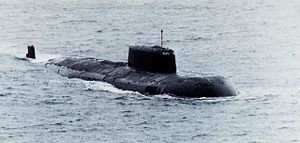From Wikipedia, the free encyclopedia
(Redirected from Oscar class submarine)
 |
|
| Class overview | |
|---|---|
| Builders: | SEVMASH, Severodvinsk |
| Operators: | |
| Preceded by: | Papa-class submarine |
| Succeeded by: | Severodvinsk-class submarine |
| Built: | 1975-1996 |
| In service: | 1981-present |
| In commission: | 1980-present |
| Building: | 2[1] |
| Planned: | 20 (2 949, 18 949A)[2] |
| Completed: | 13 (2 949, 11 949A) |
| Cancelled: | 7 (3 incomplete, 4 never laid down) |
| Active: | 5[3] |
| Laid up: | 2[3] |
| Lost: | 1 Kursk 12 August 2000 |
| Retired: | 4 |
| General characteristics | |
| Displacement: | 12,500/14,700 tons surfaced 16,500/19,400 tons submerged[2] |
| Length: | 155 m (508 ft 6 in)[2] |
| Beam: | 18.2 m (59 ft 9 in) |
| Draught: | 9 m (29 ft 6 in) |
| Installed power: | 2 × pressurized water cooled reactors |
| Propulsion: | 2 × steam turbines delivering 73,070 kW (97,990 shp) to two shafts |
| Speed: | 15 knots (28 km/h) surfaced 32 knots (59 km/h) submerged[2] |
| Endurance: | 120 days[2] |
| Complement: | 94/107[2] |
| Armament: | 4 × 533 mm (21.0 in) and 2 × 650 mm (26 in) torpedo tubes in bow 28 × 533 mm and 650 mm weapons, including Tsakra (SS-N-15 Starfish) anti-submarine missiles with 15 kt nuclear warheads and Vodopad/Veder (SS-N-16 Stallion) and anti-submarine missiles with 200 kt nuclear warhead or Type 40 anti-submarine torpedo or 32 ground mines 24 × P-700 Granit (SS-N-19 Shipwreck) cruise missiles with 750 kilograms (1,650 lb) HE or 500 kt nuclear warheads |
Project 949 submarines were the largest cruise missile submarines in service, until the Ohio-class SSGN cruise missile submarine converted from SSBN and returned to service on October 15, 2007. They are the fourth largest class of submarines in terms of displacement and length. Only the Typhoon-class Soviet/Russian submarines, the American Ohio-class ballistic missile submarines and the Russian Borei-class submarines are larger.
Contents
History
The first submarine of Project 949 was laid down in the mid-1970s and was commissioned in 1980. In 1982 an updated and larger version (Project 949A) replaced the earlier version. In total thirteen submarines were constructed. The Oscar class was designed to attack NATO carrier battle groups using long-range SS-N-19 "Shipwreck" anti-ship missiles and targeting data provided by the EORSAT satellite system.[4][5] In the financial problems that followed the fall of the Soviet Union the Oscar class was prioritized by the Russian navy and when many older submarine classes were retired the Oscar class remained active in both the Northern and Pacific fleets. In 2011, five submarines are currently active with several more in reserve or waiting for repairs.Project 949 Granit
Two Project 949 Granit submarines were built at Severodvinsk and assigned to the Soviet Northern Fleet. They were K-525 laid down in 1975 and K-206 laid down in 1979. Both were decommissioned in 1996[6] and scrapped in 2004.[7]Project 949A Antey
Eleven Project 949A Antey submarines were completed at Severodvinsk, of which five were assigned to the Soviet Northern Fleet.At one stage it had been planned to develop a new fourth-generation follow-on to the Project 949A, but this plan was later scrapped. [8]
The external differences between the two classes were that the 949A class is about 10 metres (33 ft) longer than its predecessor (~154 metres (505 ft) rather than 143 m (469 ft)), providing space for improved electronics and possibly quieter propulsion. Some sources speculate that the acoustic performance of the Oscar II class is superior to early Akula-class submarine but inferior to the Akula II as well as subsequent (4. generation) designs.[9] It also has a larger fin, and a seven-bladed propeller instead of a four-bladed one.[10]
Like all post-World War II Soviet designs, they are of double hull construction.[3] Similarly, like other Soviet submarine designs, Project 949 not only has a bridge open to the elements on top of the sail but, for use in inclement weather, there is an enclosed bridge forward and slightly below this station in the fin/sail.
A distinguishing mark is a slight bulge at the top of the fin. A large door on either side of the fin reaches this bulge. These are wider at the top than on the bottom, and are hinged on the bottom. The Federation of American Scientists[10] reports that this submarine carries an emergency crew escape capsule; it is possible that these doors cover it. The VSK escape capsule can accommodate 110 people.[11]
The Oscar Class is commonly referred to as Mongo by crews of US patrol aircraft in reference to their massive size.[citation needed]
In December 2012, construction began on a special purpose research and rescue submarine, designated project 09852, and allegedly based on project 949A (Oscar II class) submarines.[12] The submarine is designed to carry smaller submarines.[12] Some sources speculated that the boat being built/modified is actually the incomplete "Belgorod".[13] However, another source gave a different account stating that the boat is similar to AS-31 Losharik, a far smaller special purpose submarine.[14][15]
No comments:
Post a Comment